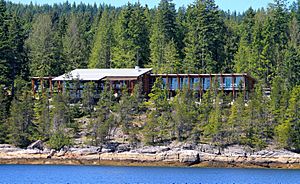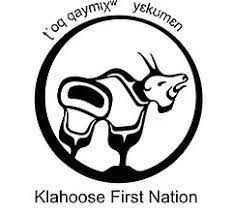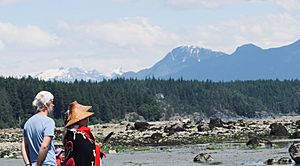Klahoose facts for kids
The Klahoose people are one of three main groups of the Tla'Amin or Mainland Comox. The other groups are the Homalco and Sliammon. These three groups share a history and are believed to be descendants of survivors of a Great Flood.
Long ago, these groups were part of a larger community known as the Tla A'min. They were also connected to the Comox people, who lived on Vancouver Island. The Klahoose are part of the larger Coast Salish family of Indigenous peoples. Their traditional language is the Comox language.
The Klahoose people are led by the Klahoose First Nation. Their main community is also called Klahoose. It is located at the top of Toba Inlet in British Columbia, Canada.
Before the Laich-kwil-tach people moved to the Campbell River area, Klahoose traditional lands stretched from there to Cortes Island. Today, Cortes Island is also claimed by the Kwiakah Nation.
The main Klahoose village is at Squirrel Cove on Cortes Island. This village has grown over the years. It now has a Health Centre and a large Multipurpose Building. This building was built in 2010. It includes a health area, a fitness center, a language lab, and a big room for community events.
The Klahoose First Nation community at Squirrel Cove does not have a year-round road to a city. This means transportation can be more expensive. People use BC Ferries to travel from Vancouver Island to Quadra Island, and then to Cortes Island.
About 75 people live full-time at Squirrel Cove. They work in the local area. Many other Klahoose people, around 300, live in other coastal communities in BC. Some also live in the lower mainland area or in Washington State.
Contents
Klahoose First Nation Government
The Klahoose First Nation is a First Nations government. It manages the affairs of the Klahoose people. Their traditional lands are around Cortes Island and Toba Inlet in southwestern British Columbia. Their historic community is at the head of Toba Inlet. This area is known as Klahoose Indian Reserve No. 1.
The Klahoose First Nation works with the governments of Canada and British Columbia. They are part of the B.C. treaty process. This process helps to define rights and land use. They have also made agreements about clean energy and forestry. For example, they have agreements for sharing revenue from projects like the Jimmie Creek Hydro Project.
The Klahoose First Nation is a member of the Naut'sa mawt Tribal Council. This council helps different First Nations work together.
Klahoose Reserve Lands
The Klahoose First Nation has several reserve lands. These areas are important for their history and culture.
AHPOKUM 9
This reserve is located at the mouth of Forbes Creek. It is on Forbes Bay in Homfray Channel. Elders tell stories that many salmon used to spawn here.
DEEP VALLEY 5
This land is on Quatam Bay, at the mouth of the Quatam River. It was a place for fishing and temporary camps.
KLAHOOSE 1
This is a large reserve at the mouth of the Toba River, at the head of Toba Inlet. This area was very important for hunting deer and catching salmon. It was the traditional winter home for the Klahoose people. While some Klahoose members grew up here, no one lives there full-time today.
QUANIWSOM 2
This small area is near the Tahumming River, also at the head of Toba Inlet. It contains a cemetery. This cemetery was used when people still lived in Toba Inlet.
QUEQUA 6
This reserve is on West Redonda Island. It is a fishing area with a rocky beach.
SALMON BAY 3
This land is at the head of Brem Bay, at the mouth of the Brem River. It was a summer village. It was known for good salmon and herring fishing. The name means 'getting humpback salmon'. This refers to how reliable it was to catch pink salmon in the Brem River.
SIAKIN 4
This reserve is on East Redonda Island. It was a fishing station, especially for dogfish. The name means 'your mouth'. This refers to its location at the mouth of two streams.
SQUIRREL COVE 8
This area is on the east side of Cortes Island, at the head of Squirrel Cove. It was used for fishing and gathering plants. The name means 'to plant a garden' or 'planted area'.
TATPO-OOSE 10
This site is on Maurelle Island. It was used as a fishing village.
TORK 7
This is the most populated village site and where the band office is located. It is on the east shore of Cortes Island at Squirrel Cove. About 75 people live here year-round.





